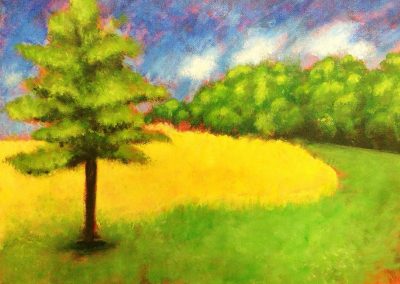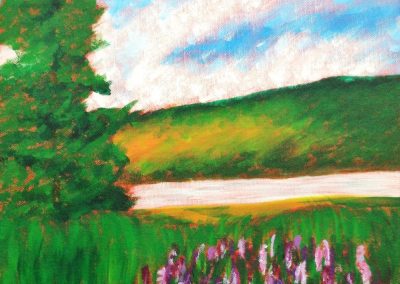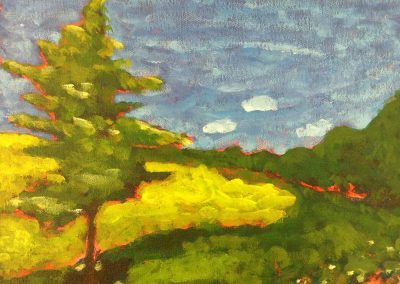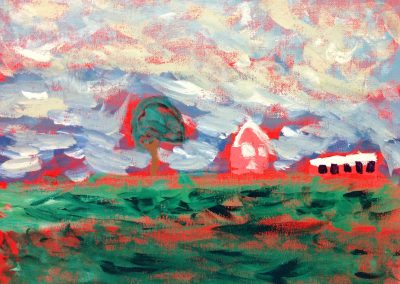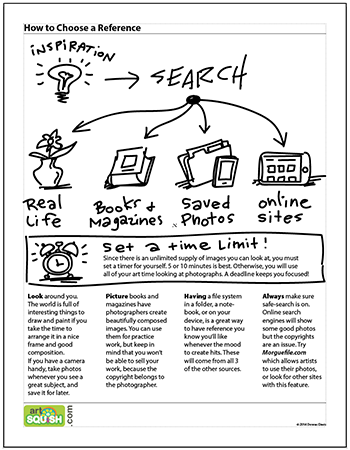Painting
Each lesson Plan focuses primarily on one of the 4 Cornerstones of Art:
Drawing | Painting | Color | Style
OVERVIEW
Students will continue working on their red underpainting landscape in acrylics until finished.Grades 6 – 12
Week of September 8 – 12
1 Hour & 45 Minutes
Lesson At A Glance
A brief overview of each step. Buttons jump to each section for detailed information.
5 Min – Review sunrise & graze-brush technique
35 Min – Finish adding details
10 Min – For early finishers
7 Min – Everyone helps
SCROLL & TEACH
LESSONPLAN
Each section is a different color. Read over once and then you can SCROLL & TEACH using any device you like. It’s designed to work best with your phone.
LEARNING TARGETS

Students know how to set up their work area for painting with acrylics.
M A T E R I A L S
- Drawing Board with attached canvas painting
- Acrylic Paints
- Brushes (all sizes)
- Water Containers
- Smocks
- Paper Towels
- Palette Pads
All materials are suggestions and may be modified as you see fit. We have tried many items, and these seem to allow the most versatility for the cost.
Brushes should be nylon for springiness and durability. Round brushes are the most versatile.
Paint pigment list:
- Napthol or Pyrrol Red
- Hansa or Light Yellow
- Pthalo Green (blue shade)
- Cyan or Cerulean Blue
- Ultramarine Blue
- Dioxazine Purple
- Magenta
- Burnt Umber
- Raw Sienna
- Titanium White (professional grade only)
1.0 Bookend
A bookend is at the beginning and the end of each lesson.
This is where you go over what the lesson is about and what the main learning points are.
Making this clear, helps students remember what they’ve learned and understand the processes they’re going through.
“Today, we’re continuing our 2-week landscape painting project, where you’ll get to practice painting on the canvas you changed from white to bright red.
Your main objective for today is to enjoy painting, and to practice painting with two techniques: sunrise, which is painting darks first, and slowly layering lighter and lighter colors, and using your brush to graze the surface rather than pressing down. We’ll review these in a minute…
1.1 REMIND
When students arrive, help them take the time to set up for painting.
Give them reminders:
- Canvas on board goes first to left or right of work area
- Smocks
- Paints lay down (don’t stand up on cap) on the other side
- Palette on same side as paints
- Water tub next to palette
- Brushes and paper towels ready
- If you have snap-open paint caps, it works best to unscrew them instead of snapping them.
CREATIONS - tap here to open
Our Creations lessons are for students who have completed the two years of Foundations and are ready to begin using all that they have learned to create new work. These more challenging versions of the same concepts and techniques are easily taught along-side students in the Foundations course. This allows for excellent review, and is encouraging for students to see progress from each viewpoint.
Use the Student Instructions printout below to distribute to your Creations students. Tap the image to open the PDF in a new window.
Painting with bright underpainted color –
These are the same instructions as last week.
Overview: Students will make a painting on their own from subject matter and reference they have found and that will have a bright warm underpainting.
Use a canvas board, a sheet of taped canvas, or a stretched canvas if available.
For your advanced students, have them warm up for 5-10 minutes with their choice of the following:
1. An accurate quick sketch of the simple modern house from the building references, with no details or texture, so they can think about the lines that make up artist’s perspective. Don’t worry over it, just try a couple of quick sketches.
2. A large and fast charcoal sketch of another person in the room or piece of furniture.
Then hand out the instructions and encourage them to move from the warmup to pondering their subject for a two-week underpainting project.
These students will be doing an advanced project, but do not let them think they can skip any of the steps for setting up, sketching, or guide-lines. This is how professional artists work. We call them foundations because we always use them. Note the following important aspects about this project.
- Underpainting color – They may use red again, or another bright warm color for the underpainting, such as hot magenta or orange. Do not use yellow without mixing in a small amount of red to be a yellow-orange. Remind them on the underpainting to not use white, but water for lightening. This makes a glaze, which is much more intense than a tint with white in it. This allows the color to affect the final painting more.
- Subject – They can do a landscape, a simple still life, or a simple photo of an animal. Simple is important since there are only two weeks. If you have more days you can go for more complexity.
- Reference – Have them search for their own reference in your library or online (Safe-search on! – We always search for students and make sure the results are safe before allowing them to view a screen). Only 5 – 10 minutes for searching maximum, and you might want to set a timer. Be strict about this, or students will spend the entire time viewing photos.
Student Instructions
These are on the PDF printout below for you to distribute to your advanced students.
Step 1. (15 minutes) UNDERPAINTING • Set up for painting in acrylic, and cover your canvas with a thin coat of a bright warm color of your choosing for an underpainting (not a background). Brilliant colors work best, so colors should be mixed with water instead of white, for a glaze effect. Landscapes look good with red. Orange and Pink can also be used. Keep the paint spread out so it will dry quickly. Set aside to dry.
Step 2. (5 min) REFERENCE • Choose a reference photo. The PDF is a good review for how to do this efficiently. As you look, think about the mood you want to convey in your work. Will it be full of bright color or will it be dark? Will the colors be contrasting or analagous?
Step 3. (15) PRACTICE & COMPOSE • Use your sketchbook to do several practice drawings. Some drawingsShould be large and sketchy, and you should do at least two or three very small thumbnail sketches to figure out your composition.
Step 4. (10) GUIDELINES • Draw some simple guidelines using your canvas pencil on the underpainting. Keep your focus on the big shapes and save the details for painting.
Step 5. PAINT • Start with the part of your subject that is the furthest away from you, such as the sky, or the wall. For each area that you paint, paint dark colors first, and continue with lighter and lighter colors. Save the lightest colors for the very end of your painting when you can see the entire effect and make good decisions for adding finishing touches.
Remember that you will also have next week to work on this painting.
Tap images to open Creations Student Instructions and Reference Materials in new windows
Use this button to jump down to the preparation section.
LEARNING TARGETS

Students know how to use different techniques in painting
2.1 REVIEW
Review different painting techniques with students. If anyone missed the first lesson, you can let them watch the video. For everyone else, a quick reminder should be all they need.
It is good to remind students of these techniques often during the lessons.
- Sunrise technique – For opaque layering. Use dark colors first, medium colors next, and light colors last, working toward the sunrise and the lightest colors.
- Graze-brush technique – hold brush sideways and use side of bristles, just tickling or grazing the surface. Don’t cover completely.
Tap the 4 arrows icon to enlarge the video to full screen.
“Painting dark to light is essential for this kind of painting. Here are some things to remember about that.
One is that you don’t need to paint the dark colors everywhere before moving to lighter ones. You can just stay in one area at a time, working dark to light before moving to the next area.
Another thing is that you can think of this like a sunrise. Start by painting the scene at night. Then add some lightness to it like the first light of the early morning. Keep creating layers of lighter paint as if you keep painting the scene while the sun rises and the light gets brighter and brighter.
Since it’s important to keep adding lighter and lighter colors, make sure that you create larger dark areas than you see or think you’ll need. You will be covering the edge of the darker areas, and it’s good to have too much rather than not enough. It’s very difficult to go back and add darks later. ”
Use this button to jump down to the preparation section.
LEARNING TARGETS

Students know how to layer opaque colors using acrylic paints.
M A T E R I A L S
- Drawing Board with painting on canvas
- Acrylic Paints
- Brushes (all sizes)
- Water Containers
- Smocks
- Paper Towels
- Palette Pads
3.1 paint
Have the students begin painting where ever they finished from last week. If the sky is not finished, that is where they should start.
Remind the class that this is the last full day to work on the landscape painting so it is important to be focused and move from one area to the next. There will be some time next week to finish, though, so on the other hand, they shouldn’t be made to feel rushed or stressed about the time.
3.2 TIPS
While students begin, have them listen while you discuss tips on how to seperate your landscape into 4 basic sections for easy painting.
Using one or more of the photo references, explain that each section of the painting is at a different distance and should be painted in sections. Within each section, paint from darks to lights, using the sunrise technique. Finish each section before moving to the next section, and start fresh with darks again.
Here is how this works:
- S K Y– The sky is farthest, and at the top. It will be made without any distinct edges and lots of fine texture using the graze-brush technique.
- D I S T A N C E– Next is the most distant hills or trees, which touch and overlap the sky. Overlapping will create more illusion as if the trees and hills are in front of the sky. This area will be fuzzy like the sky, and full of texture, but will have more distinct edges.
- M I D D L E G R O U N D– Then the trees or hills that are in-between the distant hills are next. The middle ground will overlap the most distant hills, furthering the illusion of depth. Sometimes there will be a feature in the middle ground such as a lake or a building. The middle ground will have medium sized areas and texture.
- F O R E G R O U N D– Finally, the bottom of the painting will be the closest to the viewer. When you paint this last, it will overlap the middle ground. The foreground will have larger areas and be most distinct. There will be less texture, and more objects, such as recognizable branches, flowers, and even leaves.
Use this button to jump down to the preparation section.
LEARNING TARGETS

Students know how to finish an acrylic painting
M A T E R I A L S
- Canvas Board with painting
- Acrylic Paints
- Brushes (all sizes)
- Water Containers
- Smocks
- Paper Towels
- Palette Pads
4.1 support
4.2 sign
Use this button to jump down to the preparation section.
M A T E R I A L S
- 14″ x 17″ Sketch Paper
- 11″ x 15″ watercolor paper
- 2B Pencil
- Oil pastels
Blender sticks (stumps) - Sandpaper boards (to clean blenders)
- Paper towels
5.0 Bookend
A bookend is at the beginning and the end of each lesson.
This is where you go over what the lesson is about and what the main learning points are.
Making this clear, helps students remember what they’ve learned and understand the processes they’re going through.
“If you finish your landscape painting today, that’s great, but if you don’t, you can always finish a painting later. In the class time, it’s good to learn methods and techniques, and that’s what our focus has been on the last two weeks.
You’ve learned a bunch of things:
- How to set up for painting
- How to plan and practice drawing on paper instead of the canvas
- Making guidelines with a canvas pencil
- A classic red underpainting technique – any color can be used though
- Painting dark-to-light, or a sunrise technique
- Painting with the side of your brush lightly, a graze technique
- Painting distant to near for depth
5.1 PASTELS
If students finish early, have them clean up their work area, toss their trash, and super-wash all the brushes they’ve used.
When students are done cleaning up, if there is still more time, they may try working with pencil drawing and/or oil pastels. You can do a quick demo on using oil pastels or show the demo video below. It’s up to you if you want to show the entire class, gather a small group, or just show the video to each individual student as needed.
Any subject is fine. It’s their choice. You should keep that quiet though, because some of the other students will “finish” their work immediately (and very poorly), just to get to switch to an artists choice time.
5. DEMO
Tap the 4 arrows icon to enlarge the video to full screen.
Review the demo video and demonstrate to your students, or you can simply display the video on a larger screen for them to watch.
Mix colors that seem similar. Red and yellow are warm colors, and mix well. Blue and green are cool, so they mix well too.
Use this button to jump down to the preparation section.
LEARNING TARGETS

Students know the importance of cleaning up
M A T E R I A L S
- Paper Towels
- Cleaning wipes
- Sink
- Waste baskets
- Well-lit spot for photos
- Camera or phone-camera
6.1 clean
Students set up their work area.
- Wash hands
- Super-wash brushes if used
- Put art supplies away
- Wipe tables & toss trash
- Remove any smocks (last)
- Check for items on floors and tables
6.3 photo
OBJECTIVES
- Practice and improvement using acrylic paints and graze-brush technique
- Understanding how opposite colors can look great together, and the concept of underpainting
- Accomplishment in creating a finished acrylic canvas
- Fulfillment by choosing their photo reference and mixing colors
TROUBLESPOTS
Dark colors on top of lighter ones – The sunrise technique of only painting lighter and lighter colors is extremely important for this kind of painting. Be careful towards the end of the painting time, and remind students often to not add darker colors with the graze-brush technique. If someone needs to go backwards and darken some areas that are already painted with lighter colors, DO NOT USE GRAZE BRUSH! Switch to very wet paint and fill in the dark areas solidly. Then layer medium and light colors over the edges and wherever needed after it has dried.
“House” painting – Mixing up a huge batch of one color for half your painting will make it look plain and flat, like a house wall. Artists use as many colors as possible. For instance, a tree color is not one green. If you look at even one tree, you’ll see hundreds of shades and variations of greens. A bunch of trees will have thousands. We don’t have to invent thousands of colors, but we sure do want a lot more than one.
Stray supplies – The last thing every student should do before leaving is to check the work area and the floor for supplies and trash.
Missed brushes – Sometimes a student will use more than one brush, and even if they do the brush wipe/wash/wipe and Super Wash at the end of class, they may have missed one or two brushes entirely! Make sure they’ve inventoried all the brushes and take them all for the super wash.
ART WORDS
Dry-Brush Technique – When there is not much paint on a brush, even if you press the brush down, or there is not much physical texture on the surface, there is not enough paint to cover completely. This technique will create texture.
Tickle-Brush Technique – Any time you need to convey using a light touch, young students will understand this schema-based term. For older students, use Graze-brush:
Graze-Brush Technique – This is an Art Instructor term we use to convey the SCUMBLING technique more clearly. Both can be used interchangeably, depending on age and understanding, but graze is understood, while scumbling is new (even though everyone loves to say that word!). It means using a brush lightly and just grazing across a textured surface, leaving bits of color only on the high points of the texture. In this technique, a brush should only be held with the handle almost parallel to the surface of the painting, so that the sides of the bristles are engaged instead of the tips.
Graze-brush is one type of a tickle-brush technique.
Sunrise Technique – This is an ArtSquish term we use to remember to work with our colors from DARK to LIGHT. This is essential when doing either dry-brush, or Graze-brush techniques. Light must always be on the highest spots of a textured surface, because this is how the real world looks, with shadows down low, and high lights on high spots.
When you paint the darks first, it can be a little difficult for an artist to make enough of the dark. Remind them that it’s like the night time. You will add the lights and shine light on the painting gradually working from dark to light like the sun rises.
CLASSROOM
PREP
Have paintings set out for students to continue.
Print all of your PDFs from the lesson plan and cut any references apart as needed.
What your room needs
Here are your printable lists and room prep instructions.
CLASSROOM
MATERIALS
- Art Board
- Water containers
- Smocks
- Paper towels
- Landscape PDFs
- Cheasel Reference Stand & Clip
- Sharpie Marker
STUDENT’S MATERIALS
- 14″ x 17″ Sketch Paper
- Canvas Pad
- 4B Pencil
- White Erasers
- Acrylic paints
- Brushes-all sizes
- Palette pad
- Blue tape
- Oil pastels
- Blender stick(stump)
PREVIEW
Week 5: Three Steps to Accuracy
Students will be introduced to, and have a chance to use, The 3 steps to accuracy method, which is based on the way professional artists analyze what they see so that they can reproduce it accurately in artwork. There is also a paint-mixing game, and some time to finish landscapes if needed.
Week 6: Ink & Air
Students discover (or rediscover) the good, bad, and beautiful qualities of India ink. They create a black and white ink drawing of tools, while also reviewing the 3 Steps to Accuracy, and learning about Air Shapes, the Art Instructor term for the traditional (and more abstract concept), negative shapes.



